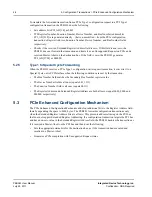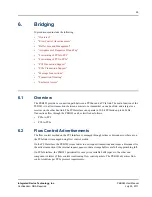
7. PCI Arbitration > PCI Arbitration Scheme
60
PEB383 User Manual
July 25, 2011
Integrated Device Technology, Inc.
Confidential - NDA Required
7.3
PCI Arbitration Scheme
The arbiter can be programmed to enable or disable, and prioritize, each requester using the
Miscellaneous Control and Status Register”
The PEB383, by default, is assigned a high priority and the other requesters are assigned a low priority.
Based on the priority setting, requesters are divided into two groups of high and low priority. Within a
group, priority is determined using a round-robin method (see
). The low-priority group is
handled as one member of the high-priority group.
By default, the PCI arbiter initially parks the bus on the PEB383. After servicing the requesters when
the bus is in idle state, the arbiter is parked on the last served requester.
The priority method is shown in
. Note that any one request input can only be mapped to high
or low priority. If, for example, PCI_REQ2n is mapped to low priority, then the H2 state is skipped
over.
Figure 18: PCI Arbitration Priority
The PEB383 also keeps track of which requestor, in each priority group, was last served. This is
achieved with two arbitration pointers, one for each priority. When a new requestor is granted the bus,
the pointer(s) advance. This gives each requestor a fair chance of being selected first when multiple
requestors request the bus.
Note
: Any device can be high
or low priority; however, a device
can have only one priority
setting as defined by the
PCI_MISC_CSR register.
L
H-PEB38x
H0
H3
H2
H1
High
Priority
L1
L2
L0
L-PEB38x
L3
Low
Priority
















































